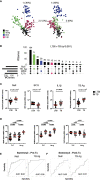Tuberculosis alters immune-metabolic pathways resulting in perturbed IL-1 responses
- PMID: 36591308
- PMCID: PMC9795069
- DOI: 10.3389/fimmu.2022.897193
Tuberculosis alters immune-metabolic pathways resulting in perturbed IL-1 responses
Abstract
Tuberculosis (TB) remains a major public health problem and we lack a comprehensive understanding of how Mycobacterium tuberculosis (M. tb) infection impacts host immune responses. We compared the induced immune response to TB antigen, BCG and IL-1β stimulation between latently M. tb infected individuals (LTBI) and active TB patients. This revealed distinct responses between TB/LTBI at transcriptomic, proteomic and metabolomic levels. At baseline, we identified a novel immune-metabolic association between pregnane steroids, the PPARγ pathway and elevated plasma IL-1ra in TB. We observed dysregulated IL-1 responses after BCG stimulation in TB patients, with elevated IL-1ra responses being explained by upstream TNF differences. Additionally, distinct secretion of IL-1α/IL-1β in LTBI/TB after BCG stimulation was associated with downstream differences in granzyme mediated cleavage. Finally, IL-1β driven signalling was dramatically perturbed in TB disease but was completely restored after successful treatment. This study improves our knowledge of how immune responses are altered during TB disease, and may support the design of improved preventive and therapeutic tools, including host-directed strategies.
Keywords: IL-1; IL-1ra; immunometabolism; systems immunology; tuberculosis.
Copyright © 2022 Llibre, Smith, Rouilly, Musvosvi, Nemes, Posseme, Mabwe, Charbit, Mbandi, Filander, Africa, Saint-André, Bondet, Bost, Mulenga, Bilek, Albert, Scriba and Duffy.
Conflict of interest statement
MLA is a current employee of HIBIO. VR was employed by DATACTIX. The remaining authors declare that the research was conducted in the absence of any commercial or financial relationships that could be construed as a potential conflict of interest.
Figures






References
-
- World Health Organization . Global tuberculosis report 2019. Geneva: World Health Organization. (2019). Licence: CC BY-NC-SA 3.0 IGO.
Publication types
MeSH terms
Substances
LinkOut - more resources
Full Text Sources
Medical

